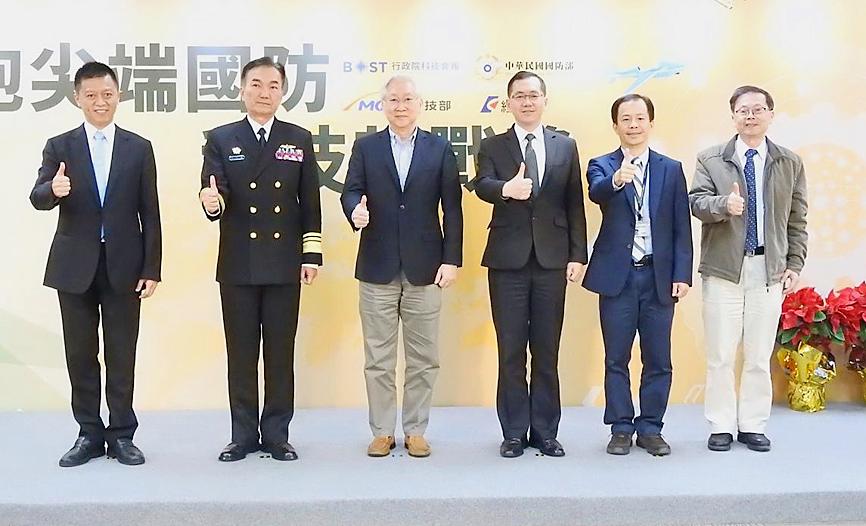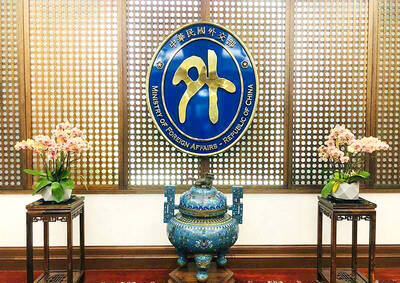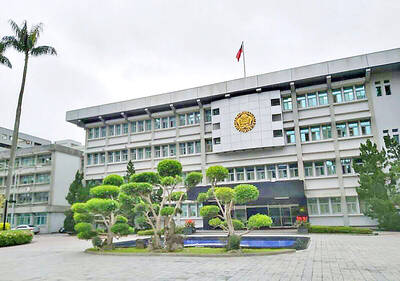The government is to budget NT$5 billion (US$175.6 million) over the next five years to promote a program on the research and development (R&D) of defense technologies at local universities, the Ministry of Science and Technology and the Ministry of National Defense announced yesterday.
The program prioritizes seven research areas: information and communications technology and smart technology; key system analysis and integration; advanced sensors and precision manufacturing; advanced propulsion systems and aerial vehicles; advanced system engineering; advanced vessels and underwater vehicles; and new material and mechanics research, the science ministry said in a news release.
The two ministries would each contribute half of the budget, Executive Yuan Office of Science and Technology Deputy Executive Secretary Andrew Yeh (葉哲良) told a news conference in Taipei.

Photo: Yang Mien-chieh, Taipei Times
In the past, defense technology was mainly developed to meet the needs of the military’s army, navy or air force branches, but now emphasis is increasingly being placed on information security and robotics amid growing demand for civilian applications and interdisciplinary talent, Yeh said.
While the military-affiliated Chungshan Institute of Science and Technology has its own information security projects, it is less sensitive to new trends in academia, and the program aims to fortify its connections, he said.
Giving an example, Yeh said that very few countries are capable of making advanced lithium batteries used in submarines and hopefully Taiwan could be among the top five countries that can produce them.
The two ministries plan to recruit 150 graduate students over five years, with each student receiving a monthly grant of NT$30,000 to NT$60,000, he said.
Foreign students cannot join the program, he added.
Universities interested in the program can submit applications to the science ministry by Tuesday, he said, adding that the ministry plans to select three to six schools to establish research centers for the program.
The promulgation of the Defense Industry Development Act (國防產業發展條例) last year shows the need for more long-term talent cultivation programs in the coming decades, Minister of Science and Technology Wu Tsung-tsong (吳政忠) said.
Technologies related to artificial intelligence, 5G and even 6G communications, Internet of Things, as well as quantum computing, are key to defense technology development, Wu said, encouraging students to study in the related fields.
The defense ministry has over the past two months met with faculty and students at National Taiwan University and National Cheng Kung University to promote defense technology, Deputy Minister of National Defense Vice Admiral Lee Tsung-hsiao (李宗孝) said.
Many experts on defense technology have worked at the Chungshan institute, while students in the new program would also be able to seek employment in the private sector, he said.

The German city of Hamburg on Oct. 14 named a bridge “Kaohsiung-Brucke” after the Taiwanese city of Kaohsiung. The footbridge, formerly known as F566, is to the east of the Speicherstadt, the world’s largest warehouse district, and connects the Dar-es-Salaam-Platz to the Brooktorpromenade near the Port of Hamburg on the Elbe River. Timo Fischer, a Free Democratic Party member of the Hamburg-Mitte District Assembly, in May last year proposed the name change with support from members of the Social Democratic Party and the Christian Democratic Union. Kaohsiung and Hamburg in 1999 inked a sister city agreement, but despite more than a quarter-century of

The Ministry of Foreign Affairs (MOFA) yesterday expressed “grave concerns” after Singaporean Prime Minister Lawrence Wong (黃循財) reiterated the city-state’s opposition to “Taiwanese independence” during a meeting with Chinese Premier Li Qiang (李強). In Singapore on Saturday, Wong and Li discussed cross-strait developments, the Singaporean Ministry of Foreign Affairs said in a statement. “Prime Minister Wong reiterated that Singapore has a clear and consistent ‘one China’ policy and is opposed to Taiwan independence,” it said. MOFA responded that it is an objective fact and a common understanding shared by many that the Republic of China (ROC) is an independent, sovereign nation, with world-leading

The Ministry of Justice Investigation Bureau (MJIB) has been investigating nine shell companies working with Prince Holding Group, and the Taipei District Prosecutors’ Office is seeking further prosecution of alleged criminals, a source said yesterday. The nine companies and three Taiwanese nationals were named by the US Department of the Treasury’s Office of Foreign Assets Control (OFAC) on Oct. 14 as Specially Designated Nationals as a result of a US federal court indictment. Prince Holding founder Chen Zhi (陳志) has been charged with fraud, conspiracy, money laundering and overseeing Prince Holding’s suspected forced-labor camps in Cambodia, the indictment says. Intelligence shared between Taiwan,

Temperatures in northern Taiwan are forecast to reach as high as 30°C today, as an ongoing northeasterly seasonal wind system weakens, the Central Weather Administration (CWA) said. CWA forecaster Tseng Chao-cheng (曾昭誠) said yesterday that with the seasonal wind system weakening, warmer easterly winds would boost the temperature today. Daytime temperatures in northern Taiwan and Yilan County are expected to range from 28°C to 30°C today, up about 3°C from yesterday, Tseng said. According to the CWA, temperature highs in central and southern Taiwan could stay stable. However, the weather is expected to turn cooler starting tonight as the northeasterly wind system strengthens again